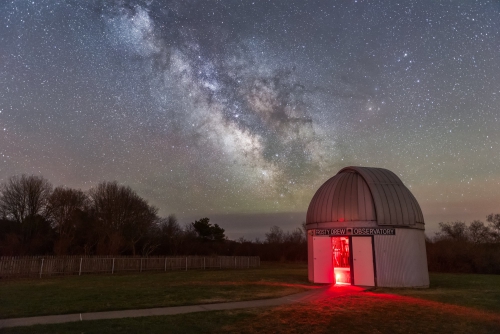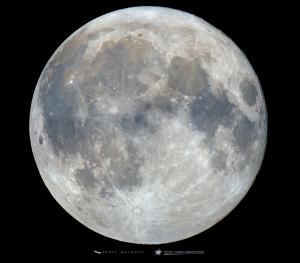
Summer Stargazing Nights
- Where:
- Frosty Drew Observatory
- When:
- Friday June 9, 2017 at 6:00 p.m
- Cost:
- $1 Suggested Donation per Person
Tonight is Stargazing Night at Frosty Drew Observatory and the skies are looking excellent! Forecasts are calling for partly cloudy skies clearing later this afternoon, leaving beautifully clear skies for us to celebrate. Being that the Full Moon happened at 9:10 a.m. ET this morning, the Strawberry Moon will be with us all night long and will render the Milky Way invisible. Additionally, Saturn will reach opposition tomorrow, which places the ringed planet in our sky nearly all night long and at best viewing.
We will open the Observatory and Sky Theatre at 6:00 tonight. In the Observatory we will offer solar observing in hydrogen alpha, showcasing prominence and filaments visible on the solar chromosphere. Once dusk kicks in, we will direct our telescopes towards the night sky. Jupiter will start of our night with fabulous views of the Great Red Spot from sunset - 10:30 p.m. Once Saturn rises high enough for our telescopes, we will rock views of the fabulous rings, which are at maximum tilt. The Moon and binary stars will frequently be on display in our court yard telescopes. In the Sky Theatre we will show our popular feature of celestial objects photographed at Frosty Drew. We will stay open until 11:30 p.m., possibly later depending on how amazing Saturn looks. Check in on our Twitter (@FrostyDrewOBSY) or for updateFacebooks from the observatory on what we are doing.
Overall, the negative effects of the bright Full Moon are easily mitigated by clear skies, a chance for views of Jupiter’s Great Red Spot, and Saturn at opposition. If the Moon is your digs, then this is a perfect night for you to be out. If dark skies and the Milky Way are your passion, you may want to sit this one out as the Moon will be super bright. Celebrate a much needed bout of clear skies with a fantastic night of Saturn, Jupiter and the Moon at Frosty Drew tonight!
------------------
Weekly Happenings
Scott MacNeill
At 9:10 a.m. this morning, the full lunar phase occurred. Generally the same view as all other Full Moon’s, the June moon is commonly referred to as The Strawberry Moon because of the relatively short strawberry harvest that happens in June. Though in the northern region of the Northern Hemisphere, the June Moon is sometimes referred to as The Honey Moon. This name originates from the Moon appearing a honey-like yellow/orange color due to its low proximity to the horizon around the time of the Summer Solstice. This happens because the Moon orbits Earth inclined 5° to the Ecliptic (the path the Sun takes across the sky and the plane of the Solar System). With the Sun near its highest point in the daytime sky, the Moon is near its lowest point in the nighttime sky. If that’s not enough, today’s Full Moon is also the furthest Full Moon from the Earth for the year. Called an apogee syzygy, a.k.a. the Mini Moon or Micromoon, the Moon reached its furthest point for the month at 6:22 p.m ET last night at a distance of 252,526 miles. So step out tonight and see if you can detect any honey-like coloring in the Full Mini Moon.
Tomorrow (Saturday, June 10th), Earth will reach the point in its orbit where Saturn is on the opposite side of the Earth than the Sun. This is called the opposition of Saturn and will be our closest point to Saturn for our year. Additionally, it is Summer Solstice on Saturn, which happens once every 30 Earth years. This places the top side of Saturn’s rings at best viewing in a 30 year period. After opposition, Saturn will be visible starting at sunset, making for many fabulous viewing ops all summer long. The weeks around opposition are the best times to catch a view. So put Saturn on your to-do list and catch an unforgettable view of the rings this month!
Take a moment to look at this image:
That is a photograph of Earth taken on February 14, 1990 by the Voyager 1 spacecraft from a distance of 3.7 billion miles.
“There are no signs of humans in this picture. Not our re-working of the Earth’s surface, not out machines, not ourselves. From this vantage point our obsession with nationalism is nowhere in evident. We are too small. On the scale of worlds, humans are in inconsequential. A thin film of life on an obscure and solitary lump of rock and metal.
Look again at that dot. That's here. That's home. That's us. On it everyone you love, everyone you know, everyone you ever heard of, every human being who ever was, lived out their lives.” -Carl Sagan
There is this common thinking that we currently live on Earth, like it’s our choice to reside here. But just like all other life that makes up this planet, we formed here, we evolved here, and we are all connected to the planet. Leaving Earth, like you would leave a house that did not suit you any further, is not as easy as many would like to think. This reality becomes increasingly clear as humans reside for longer time spans on the International Space Station. Being away from the Earth and Earth’s gravity affects our spacial orientation, head-eye and hand-eye coordination, balance, and locomotion. Without the gravity of Earth working on your body, your bones lose density at a rate of 1% per month. When returning to Earth’s gravity, that bone loss may be permanent and increases your chances of developing osteoporosis-related bone damage later in life. Without Earth’s gravity you will lose muscle strength and endurance as well as experience cardiovascular deconditioning. Fluids in your body move towards your head, increasing pressure in your eyes resulting in vision problems. Kidney stones are prevalent as the shift of fluids dehydrates you alongside the increased excretion of calcium from your bones. These are only some of the problems humans face away from Earth’s gravity, not to mention the affects of living outside of Earth’s magnetosphere.
Think of the time we spend each week learning about and taking care of our car, our house, our physique, our golf swing. At the end of the week, how much time is spent learning about and caring for Earth? There are easy, low cost changes that you can make in your life right now that can inspire a more Earth-centric way of living. Industrial cattle ranching is a massive contributor to deforestation, greenhouse gas emissions, and water table depletion. Setting and meeting goals to reduce your weekly intake of meat and animal products will promote a sustainable life style as well as reduce your carbon footprint and improve your health. Riding your bicycle to work will not only reduce your carbon footprint, but will also encourage more time spent outside while improving your health. Pay your monthly electric bill through a company that purchases Renewable Energy Credits on your behalf. These credits invest in wind, solar, and other clean energy sources, which increases the demand for clean energy, expands access and availability, and reduces your reliance on fossil fuels.
Whether we like it or not, humans are not moving to another planet anytime soon. We can ignore the problems we are causing with our delicate greenhouse and pretend they doesn’t exist, or we can do what humans do best and take on the challenge of bettering ourselves.
-Scott



